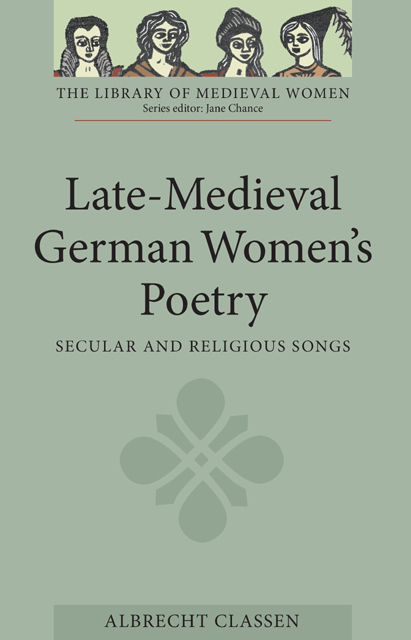Book contents
Women’s Religious Songs
Published online by Cambridge University Press: 17 March 2023
Summary
Introduction
Whereas in the case of secular women’s songs one can only guess whether the internal references provide enough justification to identify the texts as compositions by female poets, this information is usually much clearer in the case of religious songs. In many church songbooks, and in a large number of private song collections used for personal meditation, fifteenth- but mostly sixteenth-century women poets made their voices heard, demonstrating that literary and artistic creativity was not an exclusively male domain. Until recently, however, the map of latemedieval and early-modern German literature was deplorably marked by blank spots because hardly any German women writers from that period were known to us, if we disregard the famous Argula of Grumbach and Anna Ovena Hoyer. New research, however, has yielded a surprisingly large number of noteworthy women writers. To some extent the Protestant Reformation was a major factor in creating some free space, particularly for aristocratic and urban women, but we do know of some contemporary Catholic women poets who composed church songs. Whereas in the Middle Ages monastic convents provided an important framework for women to write poetry and compose liturgical music, which was then closed to a large extent in Protestant areas during the early sixteenth century, early-modern women of both denominations found a new avenue for their self-expression through the genre of the church song. This, however, does not necessarily mean that women’s composition was restricted to church song, since we may assume that women probably also composed other types of fictional text.
Although the sixteenth century was deeply influenced by the monumental struggle of the Protestant Reformers against the Catholic Church, first leading to the Protestant Reformation and later to the Catholic Counter Reformation, a vast number of readers/listeners were nevertheless still interested in purely secular themes, as is clearly documented by the so-called Volksbücher (chap books) or prose novels, the many Liederbücher with their large quantity of Volkslieder (popular songs), and dramas. At the present time, however, it is very difficult to determine whether any one of those fictional, especially non-religious, texts was indeed composed by a woman. Fortunately, this situation is beginning to change since it has been possible to locate a considerable number of (anonymous) women’s songs where a female voice at least claims authorship (see above).
- Type
- Chapter
- Information
- Late-Medieval German Women's PoetrySecular and Religious Songs, pp. 75 - 112Publisher: Boydell & BrewerPrint publication year: 2004

